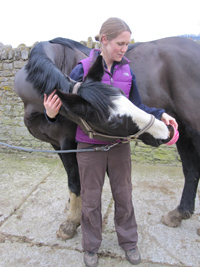

Myofascial Release
The fascia is connective tissue – in simple terms it is the white bits in your steak! It is in big ‘sheets’ lying under the skin, surrounding muscles and organs. It separates and protects areas and functions as the ‘information highway’ of the body with nerves and blood vessels running through it. Its importance should not be underestimated as tension can affect very deep structures.
Releasing fascial restrictions releases deep patterns of tension that can compromise athletic ability (and/or recovery and healing post-injury) – it is a slow hands-on technique which is non painful for the animal. As long as issues requiring veterinary attention have been ruled out, many problems can be helped through musculoskeletal manipulation (adjusting muscles and joints) and myofascial work (releasing tight muscle fascia).
The cause and not just the symptoms are addressed as the fascia is connected throughout the body, so to impact a change in the whole body all of it does not have to be touched – releasing one area has an impact on other areas.
Sports Massage
Massage is a highly effective therapy to help the muscles and soft tissues. There are various massage ‘strokes’ which are used ranging from effluerage (stroking) to trigger points release. When used in conjunction with McTimoney & other techniques it is especially effective to give a whole body treatment. Sports Massage addresses any residual muscle spasms to increase the flexibility, range of motion and as a preventative measure as subtle tissue changes are noticed at an earlier stage.
Sports Massage concentrates on muscles that are not functioning correctly. If part of a muscle has gone into spasm its range of motion and function are restricted which can create abnormal movement and discomfort. Sports massage techniques can assist in releasing the spasms and preventing injury.
Massage can also assist in reducing stress. If an animal is stressed for a prolonged period it can make it more susceptible to injury as the immune system is depleted and healing takes longer. Stress also causes higher muscle tone and an incorrect posture, which over time can lead to incorrect muscle development. For animals on box/cage rest massage can be extremely beneficial both mentally and physically. For geriatric animals massage also helps relieve compensations and helps break the pain cycle.
Here are some benefits…

- Help increase range of motion so the animal is more efficient in how it moves – leading to less wear and tear on joints/ligaments
- Help improve stamina as the animal is moving more efficiently
- Muscle injuries – assists with speeding up healing and the improves the quality of the recovery, and provides comfort
- Enhance performance and gait quality
- Improve circulation – by getting rid of waste products and bringing in nutrition
- Desensitize the animal so he/she gets used to being touched
- As a preventative measure – subtle tissue changes are noticed at earlier stages so intervention and care can begin before an injury occurs. Training issues and over or underdevelopment of one side can be addressed early.
- For horses/dogs on box/cage rest it can help to retain muscular range of motion and flexibility and circulation
- Improve recovery time from an event/competition
Masterson Method – Equine
Click on link – this explains it very well! Jim Masterson’s technique is all about using the individual horse’s natural reactions so they work with you to release tension. Incredibly effective and some brilliant treatment reactions are usually observed when areas are released!